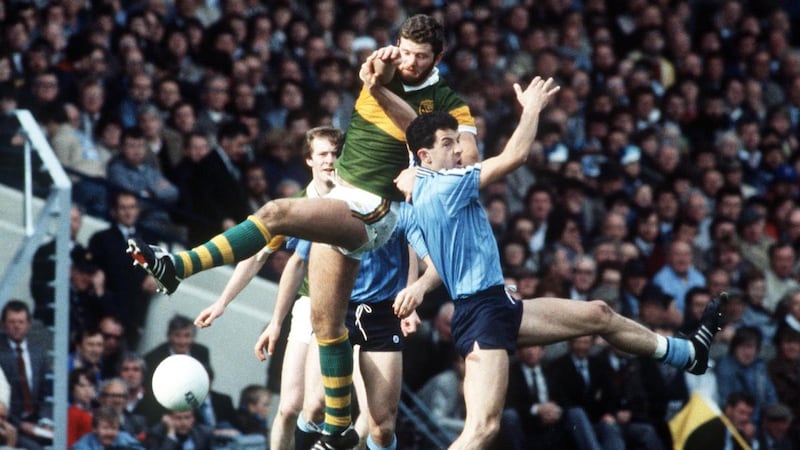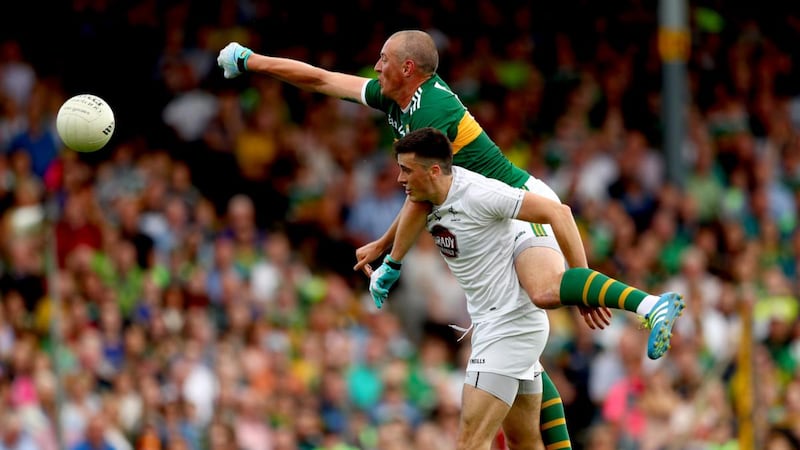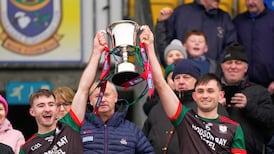Sometimes the most obvious move is the one we cannot bring ourselves to make. Why don’t Donegal do the obvious thing and build a game plan – now, this week – around Michael Murphy at full forward and see if they can win the All-Ireland?
He’s been the Donegal lodestar since he was a teenager and is in the golden years of his career. It will be a shame if they never give him a chance to truly show what he can do. Driving away from Clones on Sunday, I was convinced of this much. No team would want to face a Donegal team that had rehearsed and were committed to unleashing the potential of Murphy at full forward. It would take a bit of courage and original thinking from the Donegal coaching staff but I feel they have the time and talent to do that.
Sunday’s game spun on two miscued shots which happened to land on the edge of the Cavan small square. They resulted, because of good fortune, in two Donegal goals. I think that is the very reason why the spectacle has disappeared. Contemporary teams – and coaches – cannot countenance the thought of gambling possession: of turning the ball over by dropping in a ball for players to contest.
To my mind, they are missing a trick. From our viewing area in Clones, we could see it perfectly on Sunday. Time and time again, Murphy quietly moved into the full forward position and had a huge mismatch on Pádraig Faulkner. Very few men can live with Murphy under a dropping ball. At the other end of the field, we saw a rookie Paddy Lynch who is the prototype full forward– size, speed, strength and equipped with an eye-catching directness. He was thrilling in the first half. Until the service dried up and he ambled out the field. His raison d'etre vanished.
Paradigm shift
The game is in an era when the once mythical full forward figure is almost forgotten. But that doesn’t mean he can’t return. Strangely, the decline of the full forward has coincided with the emergence of the goalkeeper as the star position. Why or how has the goalkeeper become the key figure of the modern game? For quite a few years, coaching staffs have been incredibly bold and curious and willing to nibble around the edges of what is possible with goalkeepers. They’ve become extra outfield players, place kickers and the first point of attack through their kick-outs.
There was a time when your job as goalkeeper was to place the ball on a small hillock for the full back to lamp downfield as far as possible. Slowly but surely the goalkeeper was asked to chance the odd kick out and it all led to the paradigm shift with Stephen Cluxton and he went majnun with the kick-out. And from there, the goalkeeper became the key man.
But since Monaghan's Rory Beggan was eviscerated by Kerry in the league in Inishkeen, when he was caught out field for two decisive goals, a degree of caution has crept back in. We are seeing less adventurism this summer. Managers are cashing in those insurance policies. Goalkeepers are staying at home again.
Curiously, the glamour seemed to ebb from the No 14 position even as the focus turned to the goalkeeper. For decades in Gaelic football, the full forward had the classic role: the equivalent of the striker in football and the guy with an eye – and attitude – to score goals. Attacks were framed around him. He was allowed to be selfish. In fact, he was expected to be.
Traditional full forwards were usually men of significant physique – as were their opposite numbers. They occupied the combat zone on the edge of the square. And they rarely strolled too far from that locality.
Size, bravery and an eye for a goal were essentials. The contest for the high ball was one of the spectacles of the game. There was a time when it was deemed unfair for the full back to break the ball rather than try and fairly field it. Breaking the ball was a tactic but it was a considered a lousy one. It was a form of cheating, almost.

Full forward was not a position anyone could play. The ability to play with your back to the goalposts was critical. And that was what killed the notion that a very good midfielder could easily convert to full forward. It took time to learn how to play with your back to the goal. A natural jump was a key asset and that ability to catch a ball in a closely contested and congested space.
The No 14 on the team of the millennium was the great Tom Langan of Ballycastle and Mayo. He has been described as the greatest full forward in the history of the game. I have to rely on my father for the evidence here because I never saw him play. My father was a fair conveyor of facts. Langan wasn't quite six foot but he had a great leap and was very brave. And he had a velvety football touch.
He made his name in the All-Ireland series of 1950 and 1951: two goals in the semi-final in 50, a late goal in 51 to get a draw against Kerry and the winning goal against Meath later that year, an absolute peach. He died before his 53rd birthday on All-Ireland final day in 1974. And I feel we have been on the look-out for his replacement ever since. Now, we had 'Four Goal' Willie McGee – he hit those against Kerry in the under-21 All-Ireland final replay. But Willie also scored 17 goals from play in a senior season in league and championship, a total bettered only by Mikey Sheehy.
And the role of the forward evolved in the years after Langan. Galway's Frankie Stockwell materialised as a crafty, speedy forward. Others followed . . . Mickey Kearins, Seán O'Neill, Ray Cummins, Declan Barron – "No man jumps with Declan Barron''– all explored the boundaries of the position. They played slightly further outfield. They passed the ball!
<a class="search" href='javascript:window.parent.actionEventData({$contentId:"7.1213540", $action:"view", $target:"work"})' polopoly:contentid="7.1213540" polopoly:searchtag="tag_person">Kieran Donaghy</a> was the last old school full forward we have seen – and he was more of a facilitator and creator of scores than a scorer
And then came Eoin ‘the Bomber’ Liston. He was kind of a myth from the moment he arrived. He came with a few basketball moves, which set him apart. At the 1978 final, his dad and brother thought of leaving such were his efforts in the first half. But they stayed and watched him score a hat-trick in the second half– a hand pass, a right foot, a tomahawk fist – and the family name was forever etched on to the full forward tradition.
Paul Earley returned from Australia in the mid 1980s. Paul had actual hang-time. He had this ability to just suspend himself in the air that split second longer than those around him. And then by the 1990s, you had guys like Tony Boyle and the great Peter Canavan. Kieran Donaghy was the last old school full forward we have seen – and he was more of a facilitator and creator of scores than a scorer.
But Donegal have had this extraordinary weapon and full forward talent in Murphy and we are beginning to wonder if we will ever get to see him play a season there.
Collective potential
Ironically, I think Donegal was the county that forced others to finally forget about the old full forward virtues during the Jim McGuinness era. Their mass, smothering defence seemed to make it impossible for teams to use their full forwards. But also, Donegal advocated the idea of total football. Their backs were as happy to carry the ball and initiate attacks as their forwards: they had ball players everywhere. It’s not to say, of course, they never used Michael as an inside forward: he destroyed Mayo in the first 10 minutes of the 2012 All-Ireland final operating on the edge of the square; he would do the same to Dublin two years later.
But that was eight years ago and Donegal have not been able to find a way to unleash their collective potential to push for another All-Ireland. And I watched Murphy in Clones on Sunday and I wondered if Donegal could find it within themselves to liberate and fully use the player who carries the spirit of the traditional full forward within him.
It seems to me they have never been able to coach – or have tried to coach – their players how to use Murphy on the edge of the square. The modern defensive game is based on frustration and pushing the ball to the periphery and double and treble teaming the real stars. That is Murphy. But the one ball that constantly throws the best plans into disarray is the long high dropping ball – particularly if it is kicked at an angle.

The coaches have pretty much figured out everything else. I don’t accept you can’t do use this ploy because of the mass defence. There are huge patches of space in front of the No 14, even with the defensive unit employing a sweeper. And the likes of Murphy can still contest that ball against a sweeper. (I also believe Aidan O’Shea can do this for Mayo. Nobody will convince me otherwise.) Donaghy played 80 per cent of his Kerry career at full forward. Murphy, I imagine, is about 45 per cent for Donegal. Part of the reason is that Murphy is also one of the pre-eminent midfielders of his day.
But at full forward, he belongs to a very rare class. All that is missing is the willingness to give him the kind of ball he needs to showcase his talents: to make the direct ball to Murphy inside the abiding policy of the Donegal attacking game.
They might win Ulster by persisting with their current cautious, stop-start game, with Murphy asked to play three different roles at once. But that's as far as it goes
The quality of the in-ball, hanging on the diagonal when the full back has fronted his marker and then has to back pedal knowing that the forward is attacking the ball and coming towards it, is a perilous place to be. Kerry were fantastic at delivering those weighted hanging balls to the back post towards Donaghy. Armagh were the masters at it in the Joe Kernan era. It is doable. And I am certain that Donegal have the ball players to finesse those kinds of passes very quickly.
It is this simple. Unless Donegal use Murphy in his best position, they will not win another All-Ireland in his era. It is a shame because they have some lovely footballers.
And they have this rare talent. When Michael gets the ball in his hands, things happen. He will score, create or draw a foul. I feel they have reached a crossroads now. They might win Ulster by persisting with their current cautious, stop-start game, with Murphy asked to play three different roles at once. But that’s as far as it goes.
Their All-Ireland aspirations hang on the willingness of his coaching staff to make that decision. Donegal have good coaches. When Stephen Rochford coached Mayo, they played their most cohesive, joined-up football. He coached Corofin into playing a marvellous style. And Declan Bonner has a terrific record as a player and coach.
But: they haven’t done what they have set out to do, which was to win an All-Ireland medal. They have dominated in Ulster: a 10th final in 12 years is magnificent.
But Ulster is local! They need to go for it. They need to get back to 2012. This is the key to their unlocking the potential. They have become stagnant. Players like Langan, McGee, McGonigle, McFadden: they can do the heavy lifting out the field. Donegal should have one purpose now.
They need to use Michael Murphy as the gift that he is because they will one day discover that someone like that comes along about as often as Tom Langan.













